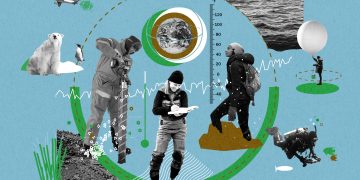Abstract
The relationship between humans and the natural world has never been static. From ancient animistic traditions to the industrial revolution and today’s Anthropocene era, the story of humankind is inextricably intertwined with the ecosystems we inhabit. This article offers a panoramic view of the historical evolution of human–nature relations, exploring philosophical underpinnings, ecological consequences, and modern pathways to re-establish a harmonious coexistence.
I. Beginnings: Humans as a Part of Nature
Long before the rise of complex civilizations, humans lived as foragers and nomadic hunters, embedded in local ecosystems.
Archaeological records show that for hundreds of thousands of years, early hominins relied on close observation of natural cycles—migration of animals, flowering of plants, seasonal rains—for survival.
Anthropologists often describe this period as the age of “embedded ecology”:
- Spiritual traditions like animism in Africa, Asia, and the Americas viewed rivers, mountains, and forests as living entities with agency and spirit.
- Resource use was largely subsistence-based; ecological footprints were minimal.
- Knowledge of plants, medicinal herbs, and animal behavior passed orally across generations, forming the first ecological knowledge systems.
Even though early humans used fire, developed stone tools, and hunted megafauna, their numbers were too small and technology too rudimentary to disrupt global ecological balances.
II. Agrarian Civilizations and the Dawn of Transformation
With the Neolithic Agricultural Revolution (c. 10,000 BCE), humans began domesticating plants and animals, altering landscapes to produce food surpluses.
This transformation brought both progress and new forms of environmental stress.
- Forests were cleared to create farmlands; river valleys were diverted for irrigation.
- Sedentary societies increased population densities, straining local ecosystems.
- Early urban centers in Mesopotamia and the Indus Valley recorded episodes of salinization and soil degradation.
- In ancient China, the concept of “Tian–Ren He Yi” (unity of Heaven and humans) in Confucian thought encouraged balance, yet large-scale hydraulic projects sometimes destabilized wetlands.
This era marked the first human-driven landscape transformations, foreshadowing later, more intensive exploitation.
III. Classical and Medieval Ecological Ethos
During the classical and medieval eras, many cultures cultivated a cosmological respect for nature, even as they expanded agriculture and trade.
- Greek philosophy (e.g., Aristotle’s “scala naturae”) placed humans atop a natural hierarchy yet emphasized the virtue of moderation.
- Roman law developed early notions of common resources such as air, water, and seashores—precursors to today’s “commons” concepts.
- In India, Buddhist and Jain traditions stressed nonviolence toward all sentient beings.
- Medieval Europe saw both deforestation for farmland and the establishment of forest preserves under feudal regimes.
- In the Islamic Golden Age, thinkers like Al-Jahiz and Ibn Khaldun observed ecological interdependencies centuries before modern ecology.
Although population growth and empire-building continued to expand human influence, a cultural thread of reverence for the natural order persisted.
IV. Industrial Revolution and the Great Acceleration
The 18th–19th centuries marked a decisive rupture.
Industrialization, powered by fossil fuels and mechanization, amplified human capacity to alter the environment on an unprecedented scale.
Key impacts included:
- Massive deforestation and land conversion for agriculture and urbanization.
- Intensive mineral extraction and coal burning, leading to air and water pollution.
- Rapid urban population growth, often accompanied by unsanitary conditions.
- Early species extinctions due to habitat loss and overhunting.
Romantic poets like Wordsworth and Thoreau mourned the loss of wilderness, while pioneers such as George Perkins Marsh in the U.S. warned of human-induced land degradation as early as 1864.
Still, the dominant ethos of the era was extraction and exploitation, driven by the logic of industrial capitalism.

V. The Birth of Modern Environmentalism
The 20th century witnessed the rise of environmental science and global conservation movements:
- Aldo Leopold’s “Land Ethic” reframed humanity as “a member and citizen of the biotic community.”
- The publication of Rachel Carson’s “Silent Spring” (1962) exposed the dangers of pesticide misuse and galvanized modern environmentalism.
- The first Earth Day (1970) in the U.S. and the establishment of the EPA reflected a shift in public consciousness.
- The UN Conference on the Human Environment (Stockholm, 1972) laid the groundwork for global environmental governance.
- The 1987 Brundtland Report coined “sustainable development,” highlighting the need to integrate environmental protection with economic growth.
Environmentalism evolved from local conservation to a planetary movement, recognizing the interconnectedness of all ecosystems and human well-being.
VI. The Anthropocene Challenge
Scientists now argue that we live in the Anthropocene, an epoch defined by human dominance over Earth’s systems:
- Anthropogenic climate change driven by greenhouse gas emissions.
- Rapid loss of biodiversity, with species extinction rates 100–1000 times the natural background rate.
- Plastic pollution reaching the deepest oceans and most remote polar regions.
- Depletion of freshwater and soil fertility threatening food security.
The Anthropocene concept reframes humanity not as a passive inhabitant of nature but as a geological force, prompting urgent calls for new forms of governance and ethics.
VII. Philosophical and Ethical Pathways to Harmony
Reimagining harmonious coexistence requires revisiting foundational ideas about the human place in nature:
- Deep ecology (Arne Naess) advocates intrinsic value for all living beings, not just their utility to humans.
- Ecofeminism links environmental exploitation to patriarchal domination, proposing relational ethics of care.
- Indigenous worldviews, long marginalized, emphasize reciprocity and stewardship rather than ownership.
- Earth jurisprudence proposes recognizing legal rights of ecosystems and non-human entities.
The philosophical turn is from anthropocentrism to ecocentrism, seeking balance rather than domination.
VIII. Modern Pathways for Coexistence
Today’s strategies for human–nature harmony integrate science, technology, policy, and culture:
- Nature-based solutions such as wetland restoration, rewilding projects, and agroforestry.
- The transition to renewable energy and circular economies to minimize ecological footprints.
- Expansion of protected areas and community-managed conservation models.
- Integration of traditional ecological knowledge into modern resource governance.
- Development of environmental education and green ethics across societies.
These approaches reflect the understanding that environmental well-being and human prosperity are mutually reinforcing, not contradictory.
IX. Case Studies: Lessons from Around the World
- Costa Rica’s Forest Revival
Through payments for ecosystem services, Costa Rica reversed deforestation and now sources over 98% of its electricity from renewables. - China’s Ecological Civilization Policy
Ambitious reforestation, wetland restoration, and renewable energy investment are reshaping landscapes and policy priorities. - Kenya’s Community Conservancies
Locally driven wildlife management demonstrates that conservation and rural livelihoods can be co-beneficial. - Europe’s Rewilding Movement
Reintroduction of species like bison and wolves to revive natural ecological processes.
These cases illustrate that harmony is achievable through policy innovation, community engagement, and respect for local contexts.
X. Toward a Shared Future
The quest for harmony between humans and nature is not nostalgic longing for a pre-industrial past; it is a forward-looking vision grounded in ecological science and global justice.
As climate change and biodiversity loss escalate, cooperation across borders, disciplines, and cultures becomes imperative.
The historical perspective shows that human societies are capable of re-envisioning their relationship with nature—from reverence to exploitation, and now, hopefully, toward reconciliation.

















































